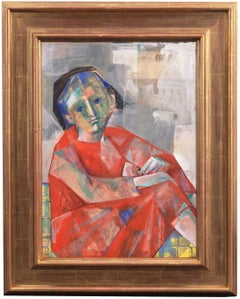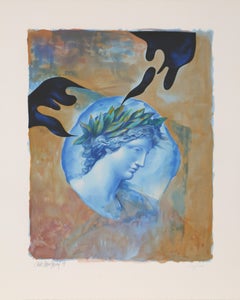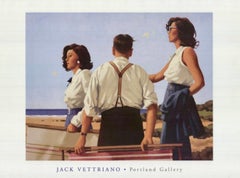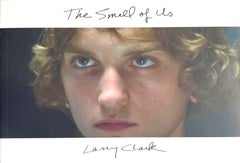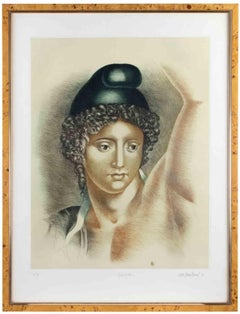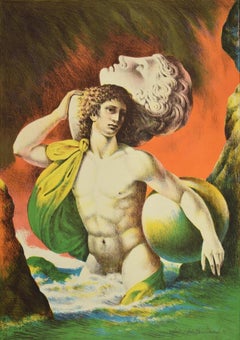Carlo Maria Mariani Art
Italian, b. 1931
Carlo Maria Mariani, born on September 15, 1931, in Rome, Italy, is a distinguished contemporary artist known for his fusion of classical traditions with modern conceptualism. Trained at the Accademia di Belle Arti in Rome under notable mentors such as Giorgio de Chirico and Renato Guttuso, Mariani has developed a multifaceted practice spanning painting, drawing, sculpture, and mixed media installations. His work, characterized by meticulous attention to detail, luminous colors, and evocative imagery, often delves into themes of classical mythology, history, and the human form while incorporating contemporary elements. Garnering international recognition since the 1960s, Mariani has exhibited his art extensively worldwide, earning prestigious awards like the Gold Medal for Painting from the President of the Italian Republic. Today, based in Rome, Mariani continues to captivate audiences with his thought-provoking creations, cementing his legacy as one of Italy's most influential contemporary artists.to
1
2
Overall Width
to
Overall Height
to
3
1
1
1
1
1
1
3
3
3
2
1
1
1
1
1
1
1
1
1
1
3
9,081
2,810
2,504
1,348
1
2
2
1
Artist: Carlo Maria Mariani
'Girl in Red', Guggenheim, LACMA, Rome, Academy of Fine Arts, Venice Biennale
By Carlo Maria Mariani
Located in Santa Cruz, CA
'Girl in Red' by Carlo Maria Mariani, 1959.
Guggenheim, Los Angeles County Museum of Art, Rome, Academy of Fine Arts, Venice Biennale
-----
Signed upper right, 'C. Mariani' for Carlo Maria Mariani (Italian, 1931-2021) and dated 1959.
Framed dimensions: 22.5 x 1.5 x 17.5 inches
A native of Rome, Carlo Mariani first studied there at the Academy of Fine Arts where he was influenced by the prevailing styles of Hyper-Realism and Conceptualism. In 1994, he moved to New York City where he began to paint figural landscapes in a traditional, neo-classical style. The 1990s brought Mariani wide recognition and numerous honors, as he represented Italy three times at the Venice Biennale. Additionally, in 1998, he received the prestigious Antonio Feltrinelli Award for lifetime achievement in painting.
Mariani continues to be best known for his refined and painterly, Renaissance technique. He was a central figure in Rome’s avant-garde in the 1970s and is widely regarded as an influential forerunner of 1980's Postmodernism. He achieved an international reputation, beginning in the early 1980s, for his arcane and, often, controversial paintings...
Category
1950s Post-Impressionist Carlo Maria Mariani Art
Materials
Paper, Gouache
In Coronato (The Crowning), Screenprint by Carlo Maria Mariani
By Carlo Maria Mariani
Located in Long Island City, NY
Artist: Carlo Maria Mariani, Italian (1931 - )
Title: In Coronato (The Crowning)
Year: 1999
Medium: Screenprint, signed, dated, and numbered in pencil
Edition: 108
Image Size: 25 x...
Category
1990s Modern Carlo Maria Mariani Art
Materials
Screen
Spoleto Festival - Original Offset and Lithograph by Carlo Maria Mariani - 1989
By Carlo Maria Mariani
Located in Roma, IT
Spoleto Festival is an original offset and lithograph on cardboard, realized by Carlo Maria Mariani in 1989.
Signed on plate.
Good conditions.
Carlo Maria Mariani (Rome, 1931) is an Italian painter. Carlo M. Mariani creates works whose conception refers to classical art: from ancient Greece and ancient Rome. Without copying directly from works of the past. This characteristic makes Mariani a painter in line with the characteristics of late seventies painting...
Category
1980s Contemporary Carlo Maria Mariani Art
Materials
Lithograph, Offset
Related Items
Young Hearts, Portland Gallery London offset lithograph
By Jack Vettriano
Located in Hillsborough, NC
Jack Vettriano (1951-) is renowned for his film noir oil paintings and 1930s glam style. Uniquely Vettriano, ‘Young Hearts’ is set by the seaside inviting narratives about the figures in his work: relationships, anticipation, power and suggestion.
Vettriano grew up by the Fife Scottish coast. He began painting beach scenes as a young adult, later developing his particular recognizable style and thematic imagery. His work was embraced by celebrities such as Madonna and Jack Nicholson and he has become hugely successful. His most famous painting, ‘The Singing Butler...
Category
Early 2000s Contemporary Carlo Maria Mariani Art
Materials
Lithograph, Offset
The Smell of Us (Limited edition softcover book)
By Larry Clark
Located in New York, NY
Larry Clark
The Smell of Us, 2015
Limited Edition softcover book printed on heavy paper stock in oblong binding (Edition: 250)
5 1/2 × 8 inches
This first edition book by Larry Clark...
Category
2010s Contemporary Carlo Maria Mariani Art
Materials
Mixed Media, Lithograph, Offset
Vogue Magazine, Elegant Fashion Illustration for Adel Simpson
By Antonio Lopez
Located in Miami, FL
Vogue USA, Fashion Illustration. Meticulously drawn in a descriptive and yet creative way. Antonio's full mastery of his art is on full display. Signed lower right. The work is arch...
Category
1980s Post-Impressionist Carlo Maria Mariani Art
Materials
Watercolor, Gouache, Pencil
$9,000
H 21 in W 12.5 in D 1 in
DAVID SHRIGLEY - Just Fly Away. Modern Design Figurative British Artist Blue
By David Shrigley
Located in Madrid, Madrid
DAVID SHRIGLEY - WITNESS MY JOY
Date of creation: 2023
Medium: Archival digital print on Hahnemuhle Photo Rag paper
Edition: 125
Size: 76 x 56 cm
Condition: In mint condition, brand ...
Category
1970s Modern Carlo Maria Mariani Art
Materials
Paper, Varnish, Screen
$6,282
H 29.53 in W 22.05 in
The Sprinters, for 1984 Los Angeles Olympics with official COA Lt Ed Hand Signed
By John Baldessari
Located in New York, NY
John Baldessari
The Sprinters, 1982
Limited Edition Offset Lithograph on Parson's Diploma paper
Signed in graphite pencil on the front. Accompanied by letter of authenticity from the publisher
36 x 24 inches
Unframed
Provenance:
Acquired as part of the complete SIGNED 1984 Olympic Lithographic Print Portfolio
Exhibition History:
Olympic Museum in Lausanne, Switzerland, 2017 (different edition)
Accompanied by a letter of authenticity from the publisher on Olympic Committee letterhead. This is one of 750 hand signed lithographic posters, published in 1982 to celebrate the 1984 Los Angeles Olympics...
Category
1980s Contemporary Carlo Maria Mariani Art
Materials
Offset, Lithograph
Walk Through Walls : A Memoir (Official Hand Signed copy of hardback monograph))
By Marina Abramovic
Located in New York, NY
Marina Abramović
Walk Through Walls : A Memoir (Official Hand Signed copy), 2016
First Edition hard cover monograph, hand signed by artist and Stamped "Signed" with Strand Bookshop s...
Category
2010s Contemporary Carlo Maria Mariani Art
Materials
Mixed Media, Lithograph, Offset
$200
H 9.5 in W 6.5 in D 1.25 in
Stewart Wheeler, Atlantic City (New Jersey)
Located in New York, NY
The little that is know about the painter and printmaker Stewart Wheeler indicates that most of his career was spent in Philadelphia, Pennsylvania. And...
Category
Mid-20th Century American Modern Carlo Maria Mariani Art
Materials
Screen
DAMIEN HIRST - EMPRESSES: SUIKO Limited Modern Butterflies glitter red
By Damien Hirst
Located in Madrid, Madrid
Damien Hirst - THE EMPRESSES - SUIKO
Date of creation: 2022
Medium: Laminated giclée print on aluminium composite and screen printed with glitter.
Edition number: 1191/3310 (1.657 ph...
Category
2010s Modern Carlo Maria Mariani Art
Materials
Glitter, Panel, Giclée, Screen
$9,515
H 39.38 in W 39.38 in D 0.4 in
Original Les Codes de CHANEL French fashion poster
Located in Spokane, WA
Original Les Codes de CHANEL Poster – Pink Fashion Wall Art, Modern Luxury Décor, Iconic Designer Brand Print for Bedroom, Living Room, Glam Office poster. Archival linen backed in...
Category
2010s American Modern Carlo Maria Mariani Art
Materials
Screen
The Boundaries Of Our Realities Are Set By The Limits Of Our Imagination
By The Connor Brothers
Located in New York, NY
A pristine color screenprint, acrylic and oil paint and varnish over giclée on paper. Signed and dated in white ink by the Connor Brothers. Dimensions with the frame are 32 x 22 inches.
Category
2010s Modern Carlo Maria Mariani Art
Materials
Paper, Varnish, Oil, Acrylic, Color, Giclée, Screen
$6,000
H 29.25 in W 19.5 in
DAVID SHRIGLEY - BLACK CATS EVERYWHERE. Modern Design British Artist Blue
By David Shrigley
Located in Madrid, Madrid
DAVID SHRIGLEY - Black Cats Everywhere
Date of creation: 2021
Medium: 12 colour screenprint on Somerset satin paper
Edition: 125
Size: 75 x 56 cm
Condition: Brand new, in mint cond...
Category
1970s Modern Carlo Maria Mariani Art
Materials
Paper, Screen
$6,283
H 29.53 in W 22.05 in
Original French Art Deco Gouache Illustration Drawing by J. Hilly
Located in Atlanta, GA
An original Art Deco illustration hand-painted with ink and gouache on paper. The drawing features two elegant women with large windows and drapery in the background. This image was ...
Category
1930s Art Deco Carlo Maria Mariani Art
Materials
Paper, Ink, Gouache
$500
H 15.57 in W 12 in D 2 in
Previously Available Items
Ganimede - Lithograph by Carlo Maria Mariani - 1982
By Carlo Maria Mariani
Located in Roma, IT
Ganimede is a contemporary artwork realized by the artist Carlo Maria Mariani in 1982.
Mixed colored etching
Hand signed, dated and numbered on the lower margin.
Edition of 37/80....
Category
1980s Modern Carlo Maria Mariani Art
Materials
Lithograph
H 33.08 in W 25.2 in D 0.79 in
Mythology - Original Lithograph by Carlo Maria Mariani - 1986
By Carlo Maria Mariani
Located in Roma, IT
Mythology is an original lithograph on cardboard realized by Carlo Maria Mariani in 1986.
Hand-signed, numbered, and dated in pencil on the lower right.
Edition,90/100.
Good conditions.
Carlo Maria Mariani (Rome, 1931) is an Italian painter. Carlo M. Mariani creates works whose conception refers to classical art: from ancient Greece and ancient Rome. Without copying directly from works of the past. This characteristic makes Mariani a painter in line with the characteristics of late seventies painting...
Category
1980s Contemporary Carlo Maria Mariani Art
Materials
Lithograph
H 27.17 in W 19.3 in D 0.04 in
Carlo Maria Mariani art for sale on 1stDibs.
Find a wide variety of authentic Carlo Maria Mariani art available for sale on 1stDibs. You can also browse by medium to find art by Carlo Maria Mariani in gouache, lithograph, offset print and more. Much of the original work by this artist or collective was created during the 20th century and is mostly associated with the Post-Impressionist style. Not every interior allows for large Carlo Maria Mariani art, so small editions measuring 12 inches across are available. Customers who are interested in this artist might also find the work of Bruno Conte, Robert Moesle, and Ruth Gikow. Carlo Maria Mariani art prices can differ depending upon medium, time period and other attributes. On 1stDibs, the price for these items starts at $334 and tops out at $8,500, while the average work can sell for $760.
